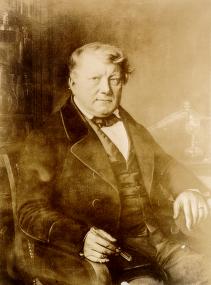Christian Friedrich Schönbein
| Christian Friedrich Schönbein | |
|---|---|

Christian Friedrich Schönbein
|
|
| Born |
18 October 1799 Metzingen, Duchy of Württemberg |
| Died | 29 August 1868 (aged 68) Baden-Baden, Germany |
| Residence | Germany, Switzerland |
| Nationality | German |
| Institutions | University of Basel |
| Known for | Fuel cell, ozone, guncotton |
Christian Friedrich Schönbein (18 October 1799 – 29 August 1868) was a German-Swiss chemist who is best known for inventing the fuel cell (1838) at the same time as William Robert Grove, Robert Cumming and his discoveries of guncotton and ozone.
Schönbein (Schoenbein) related to Michael Schoenbein was born at Metzingen in the Duchy of Württemberg. Around the age of 13 he was apprenticed to a chemical and pharmaceutical firm at Böblingen. Through his own efforts, he acquired sufficient scientific skills and knowledge to ask for, and receive, an examination by the professor of chemistry at Tübingen. Schönbein passed the exam and, after a series of moves and university studies, eventually acquired a position at the University of Basel in 1828, becoming a full professor in 1835. He remained there until his death in 1868, and was buried in Basel.
It was while doing experiments on the electrolysis of water at the University of Basel that Schönbein first began to notice a distinctive odor in his laboratory. This smell gave Schönbein the clue to the presence of a new product from his experiments. Because of the pronounced smell, Schönbein coined the term "ozone" for the new gas, from the Greek word "ozein", meaning "to smell". Schönbein described his discoveries in publications in 1840. He later found that the smell of ozone was similar to that produced by the slow oxidation of white phosphorus.
The ozone smell Schönbein detected is the same as that occurring in the vicinity of a thunderstorm, an odor that indicates the presence of ozone in the atmosphere.
Although his wife had forbidden him to do so, Schönbein occasionally experimented at home in the kitchen. One day in 1845, when his wife was away, he spilled a mixture of nitric acid and sulfuric acid. After using his wife's cotton apron to mop it up, he hung the apron over the stove to dry, only to find that the cloth spontaneously ignited and burned so quickly that it seemed to disappear. Schönbein, in fact, had converted the cellulose of the apron, with the nitro groups (added from the nitric acid) serving as an internal source of oxygen; when heated, the cellulose was completely and suddenly oxidized.
...
Wikipedia
